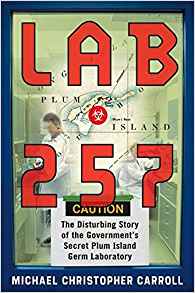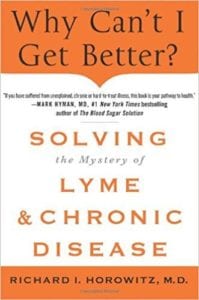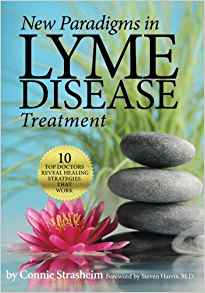A brand new disease appeared in Old Lyme, Connecticut, just north of Plum Island in July 1975 when two mothers desperately sought medical help regarding the mysterious outbreak of arthritis and juvenile arthritis in their families and town. In the face of unexplainable symptoms and unsatisfying diagnoses, they reached out to the Connecticut State Department of Health and the Yale School of Medicine, sparking an investigation that would culminate in the characterization of what is now widely known as Lyme disease.
And what was on Plum Island? A germ warfare lab to which the U.S. government had brought former Nazi germ warfare scientists in the 1940s (Project Paperclip) to work on the same evil work for a different employer. These included the head of the Nazi germ warfare program who had worked directly for Heinrich Himmler. On Plum Island was a germ warfare lab that frequently conducted its experiments out of doors. After all, it was on an island. What could go wrong? Documents record outdoor experiments with diseased ticks in the 1950s. Even the indoors, where participants admit to experiments with ticks, was not sealed tight. And test animals mingled with wild deer, test birds with wild birds.
By the 1990s, the eastern end of Long Island had by far the greatest concentration of Lyme disease. If you drew a circle around the area of the world heavily impacted by Lyme disease, which happened to be in the Northeast United States, the center of that circle was Plum Island.
Plum Island experimented with the Lone Star tick, whose habitat at the time was confined to Texas. Yet it showed up in New York and Connecticut, infecting people with Lyme disease — and killing them. The Lone Star tick is now endemic in New York, Connecticut, and New Jersey.
Plum Island is where Lab 257 has been located since 1954, ostensibly for animal viral research. That soon morphed into bioweapons research, which was supposedly canceled by Richard Nixon in 1969. But later documents revealed that bioweapon research had continued in secrecy. Plum Island is the open air laboratory for Ft. Detrick, the notorious bioweapon center in Maryland.
 From NY attorney Michael Carroll’s book, Lab 257: The Disturbing Story of the Government’s Secret Plum Island Germ Laboratory: “Plum Island presents more vectors for the spread of infectious disease than perhaps anywhere else. Ticks [there] have a long and varied menu: droves of small foraging birds… a tantalizing wild deer habitat, and thousands of mice and rats for tick larvae and nymphs to feed on. Plum Island is a Lyme disease tinderbox.”
From NY attorney Michael Carroll’s book, Lab 257: The Disturbing Story of the Government’s Secret Plum Island Germ Laboratory: “Plum Island presents more vectors for the spread of infectious disease than perhaps anywhere else. Ticks [there] have a long and varied menu: droves of small foraging birds… a tantalizing wild deer habitat, and thousands of mice and rats for tick larvae and nymphs to feed on. Plum Island is a Lyme disease tinderbox.”
Lone Star hard ticks, formerly indigenous only to Texas, suddenly proliferated in the Long Island/Connecticut area right around the time LD broke out. No one could explain how they suddenly migrated there. Hard ticks are bioweapon researchers’ ticks of choice for spreading pathogens to wild life.
Despite government denial, there have been some discoveries concerning bioweapon research on mycoplasma, living particles of bacterial nucleic acid without cell walls, pointing to Plum Island’s involvement with LD. Some US government scientists hold a patent on a pathogenic mycoplasma fermentans converted into a crystalline form. This patent includes the disease symptoms of LD that can be carried by insects or birds! Crystalline mycoplasma fermentans contains the Bb that causes Lyme disease.
Attorney Michael Carroll, knowledgeable health experts, and LD victims consider infected insects or birds released inadvertently or intentionally from Plum Island as the source of worldwide Lyme disease in all its disguises.
“A source who worked on Plum Island in the 1950s,” the book states, “recalls that animal handlers and a scientist released ticks outdoors on the island. ‘They called him the Nazi scientist, when they came in, in 1951—they were inoculating these ticks.” Lab 257 goes on: “Dr. Traub’s World War II handiwork consisted of aerial virus sprays developed on Insel Riems and tested over occupied Russia, and of field work for Heinrich Himmler in Turkey. Indeed, his colleagues conducted bug trials by dropping live beetles from planes. An outdoor tick trial would have been de rigueur for Erich Traub.”
Traub was brought to the U.S. with the end of the war under Project Paperclip, a program under which Nazi scientists, such as Wernher von Braun, came to America.
“Traub’s detailed explanation of the secret operation on Insel Riems” given to officials at Fort Detrick in Maryland, the Army’s biological warfare headquarters, and to the CIA, “laid the groundwater for Fort Detrick’s offshore germ warfare animal disease lab on Plum Island. Traub was a founding father,” says Lab 257.
And Plum Island’s purpose, says the book, became what Insel Riems had been: to develop biological warfare to be directed against animals in the Soviet Union, with the Cold War conflict between the U.S. and the Soviet Union having begun.
Traub also developed relationships in the U.S. before the war. He “spent the prewar period of his scientific career on a fellowship at the Rockefeller Institute in Princeton, New Jersey, perfecting his skills in viruses and bacteria under the tutelage of American experts before returning to Nazi Germany on the eve of war,” says Lab 257. While in the U.S. in the 1930s, too, relates Carroll, an attorney originally from Long Island, Traub was a member of the Amerika-Deutscher Volksbund which was involved in pro-Nazi rallies held weekly in Yaphank on Long Island.
The pathogen responsible for LD is spirochete Borrelia burgdorferi (Bb), the wiggly form of Bb. It is a cell wall deficient (CWD) bacteria, which makes it difficult to destroy since most antibiotics function by destroying the cell walls of bacteria.
It has been believed that Lyme disease was transferred only from insect bites, mostly ticks. But evidence has emerged for many to believe otherwise. Though infected insects may be the point of initial transfer to humans, there have been babies who were born with Lyme disease because of the mothers’ infection. A few families have a majority of family members with LD. Were they all bitten by insects? One researcher has discovered Bb in tears, so wiping one’s eyes could spread it manually.
A few medical research scientists and doctors have discovered Bb in virtually all studied victims of Parkinson’s Disease, Alzheimer’s, fibromyalgia, and others. How many other chronic degenerative diseases, often with neurological symptoms, can be related to this Bb pathogen? Remember, LD mimics many diseases.
There are several doctors and researchers who believe that LD or the Bb pathogen has contaminated millions internationally, but most of them have been diagnosed with standard neurological or degenerative diseases. Many methods of Bb contamination in addition to tick bites have been exposed since 2000.
So we have a mysterious pathogen that mimics many diseases, making it difficult to diagnose, is difficult to isolate and destroy, is contagious, and incapacitates all those infected. That certainly fits the criteria of an effective bioweapon!
Traub’s pre-war and pre-Project Paperclip connection to the Rockefeller Institute was pointed out above. Keep in mind, with John D. Rockefellers control over the medical industry from 1910 on, he is in a unique position to greatly profit from disease… plus he can forward the New World Order depopulation agenda in a very obscure manner.
Also…
…[R]esearch reveals that Zika was discovered in Uganda in 1947, extracted from the blood of a sentinel rhesus monkey, then collected by the Rockefeller Foundation and now sold (Zika Virus ATCC® VR-84™) [#3]. The Rockefeller Foundation receives royalties upon selling it, and it is trademarked – but it is unclear if it is patented by them. If it is, it would indicate it was bio-engineered after from the first sample. The Rockefeller Foundation has laboratories in the Brazil jungles which conducted bioweapon experiments going back to the 1940s [#4]. This clearly links the Rockefeller Foundation to Zika and bioweapons for generations. Then we find the other link – the Gates Foundation and the Rockefeller Foundation have formed various alliances [#5] in green science, GMO and bioengineering projects based around ‘helping the third world’.
Resources:
- https://www.ncbi.nlm.nih.gov/pmc/articles/PMC3117402/
- http://www.naturalnews.com/028864_Lyme_Disease_remedies.html
- https://www.counterpunch.org/2015/10/02/the-politics-of-lyme-disease/
- http://www.rense.com/general67/plumislandlyme.htm
See also:
- Dr Mercola: The Unknown Epidemic: Part 1
- Dr Mercola: The Unknown Epidemic: Part 2
- Prevalence of Lyme Disease in the US Is 10-Times Higher Than Previously Reported
Watch Lyme disease documentary “Under Our Skin”
Recommended Books:
 From one of the country’s foremost doctors comes a ground-breaking book about diagnosing, treating and healing Lyme, and peeling away the layers that lead to chronic disease.
From one of the country’s foremost doctors comes a ground-breaking book about diagnosing, treating and healing Lyme, and peeling away the layers that lead to chronic disease.
You may not know that you have Lyme. It can mimic every disease process including Chronic Fatigue Syndrome, Fibromyalgia, autoimmune conditions like MS, psychiatric conditions like depression and anxiety, and cause significant memory and concentration problems, mimicking early dementia. It is called the “Great Imitator,” and inaccurate testing-combined with a fierce, ongoing debate that questions chronic infection-makes it difficult for sufferers to find effective care.
When Dr. Richard Horowitz moved to the Hudson Valley over two decades ago to start his own medical practice, he had no idea that he was jumping into a hotbed of Lyme disease. He would soon realize that many of the chronic disease diagnoses people were receiving were also the result of Lyme-and he would discover how once-treatable infections, in the absence of timely intervention, could cause disabling conditions. In a field where the number of cases is growing exponentially around the world and answers remain elusive, Dr. Horowitz has treated over 12,000 patients and made extraordinary progress. His plan represents a crucial paradigm shift, without which the suffering will continue.
In this book, Dr. Horowitz:
- Breaks new ground with a 16 Point Differential Diagnostic Map, the basis for his revolutionary Lyme treatment plan, and an overarching approach to treating all chronic illness.
- Introduces MSIDS, or Multiple Systemic Infectious Disease Syndrome, a new lens on chronic illness that may prove to be an important missing link.
- Covers in detail Lyme’s leading symptoms and co-infections, including immune dysfunction, sleep disorders, chronic pain and neurodegenerative disorders – providing a unique functional and integrative health care model, based on the most up-to-date scientific research, for physicians and health care providers to effectively treat Lyme and other chronic illnesses.
Cutting through the frustration, misinformation and endless questions, Dr. Horowitz’s enlightening story of medical discovery, science and politics is an all-in-one source for patients of chronic illness to identify their own symptoms and work with their doctors for the best possible treatment outcome.
 “Connie Strasheim’s book is a MUST-READ for anyone who has Lyme disease; for those who suspect that they might have it or who are concerned about exposure to it, and for those who have friends or family members with it. It is packed with plenty of NEW, useful and easy-to- understand information about Lyme, its coinfections and various co-conditions. For this book, Connie interviewed ten leading Lyme specialists, including one from Germany, one from Canada and eight from the USA -all of which have an integrative approach to treatment. The experts all agree that certain treatment steps are essential for recovery, but all have a unique treatment approach and provide their own pearls of wisdom. I congratulate Connie for a job VERY well done!”
“Connie Strasheim’s book is a MUST-READ for anyone who has Lyme disease; for those who suspect that they might have it or who are concerned about exposure to it, and for those who have friends or family members with it. It is packed with plenty of NEW, useful and easy-to- understand information about Lyme, its coinfections and various co-conditions. For this book, Connie interviewed ten leading Lyme specialists, including one from Germany, one from Canada and eight from the USA -all of which have an integrative approach to treatment. The experts all agree that certain treatment steps are essential for recovery, but all have a unique treatment approach and provide their own pearls of wisdom. I congratulate Connie for a job VERY well done!”
– W. Lee Cowden, MD, MD(H) Chairman, Scientific Advisory Board Academy of Comprehensive Integrative Medicine
Recent years have brought dramatic changes in how top doctors are treating Lyme disease. New paradigms in Lyme disease treatment have emerged and are helping people to recover, even those that have failed years of treatments. This book is based on interviews with ten leading Lyme doctors, and takes you deep into their treatment programs, so you can see for yourself what is new and different about modern Lyme treatment. No matter how many Lyme disease books you’ve already read, you don’t want to miss the new treatment strategies presented in this book.
Writer Connie Strasheim is no stranger to interviewing Lyme disease doctors. This is the second doctor interview book she has written on the topic of treating Lyme disease. Her first, entitled Insights Into Lyme Disease Treatment, has sold more than 15,000 copies and was based on interviews with over a dozen Lyme-treating physicians. Connie’s experience in health care journalism (with a specific focus on Lyme disease) has allowed her to become an expert in extracting only the most important information from busy doctors who have a treasure vault of Lyme treatment wisdom stored in their brains.In her interviews with the doctors, Connie asks a broad array of questions designed to bring you the most cutting-edge, practical, and useful information possible.
The Internet age has ushered in a near-infinite number of ways to research Lyme disease. But wisdom on the best way to successfully overcome Lyme disease isn’t found in a Google search, but instead, is contained within the minds of doctors who treat this disease day-in and day-out, and who have experience treating thousands of patients.
Traveling to have appointments with each of the doctors interviewed in this book would take weeks, and cost thousands of dollars. And even if you did make the trips, would the doctors have enough time to answer all of your questions? Would you even know which questions to ask? Here, Connie does all the hard work for you, so that you can read about new, important paradigms and tools in Lyme disease treatment from the comfort of your own home. These tools, which are bringing healing, life, and new hope to thousands, may do just the same for you!
 Despite Centers for Disease Control estimates that only 20,000 new Lyme disease infections occur each year, the true figure, as Harvard medical school researchers have found, nearly approaches 200,000. Symptoms run from mild lethargy to severe arthritis to incapacitating mental dysfunction. And despite medical pronouncements to the contrary, extensive research has found that tests for the disease are not very reliable and antibiotics are only partially effective; up to 35 percent of those infected will not respond to treatment or will relapse. The spirochetes that cause Lyme are stealth pathogens–they can hide within cells or alter their form so that antibiotics cannot affect them. Lyme disease is, in fact, a potent, emerging epidemic disease for which technological medicine is only partially effective.
Despite Centers for Disease Control estimates that only 20,000 new Lyme disease infections occur each year, the true figure, as Harvard medical school researchers have found, nearly approaches 200,000. Symptoms run from mild lethargy to severe arthritis to incapacitating mental dysfunction. And despite medical pronouncements to the contrary, extensive research has found that tests for the disease are not very reliable and antibiotics are only partially effective; up to 35 percent of those infected will not respond to treatment or will relapse. The spirochetes that cause Lyme are stealth pathogens–they can hide within cells or alter their form so that antibiotics cannot affect them. Lyme disease is, in fact, a potent, emerging epidemic disease for which technological medicine is only partially effective.
Healing Lyme examines the leading, scientific research on Lyme infection, its tests and treatments, and outlines the most potent herbal medicines and supplements that offer help–either alone or in combination with antibiotics–for preventing and healing the disease. It is the essential guide to Lyme infection and its treatment.
 “Horowitz is one of the most prominent ‘Lyme literate’ physicians…patients wait for months to see him, and several told me that he had essentially cured them of a disease that nobody else seemed able to treat.” ―The New Yorker
“Horowitz is one of the most prominent ‘Lyme literate’ physicians…patients wait for months to see him, and several told me that he had essentially cured them of a disease that nobody else seemed able to treat.” ―The New Yorker
“If you have suffered from unexplained, chronic or hard-to-treat illness, this book is your pathway to health.” ―Mark Hyman, #1 New York Times bestselling author of The Blood Sugar Solution on Why Can’t I Get Better?
From Dr. Richard I. Horowitz, one of the country’s foremost doctors, comes a ground-breaking book about diagnosing, treating and healing Lyme, and peeling away the layers that lead to chronic disease.
Are you sick, but can’t find any answers why? Do you have a seemingly unconnected collection of symptoms that leave doctors guessing? Or have you been diagnosed, but found that none of the treatments seems to make a difference? You may have Lyme disease and not even know it. Known as “the great imitator,” Lyme disease and its associated co-infections can mimic the symptoms of and often be misdiagnosed as Chronic Fatigue Syndrome, fibromyalgia, rheumatoid arthritis, lupus, multiple sclerosis, and even depression, anxiety, obsessive-compulsive disorder, and psychosis.
In his landmark book, Why Can’t I Get Better?: Solving the Mystery of Lyme & Chronic Disease, renowned internist and leading world expert Dr. Horowitz introduced his revolutionary plan for treating Lyme disease, and chronic diseases in general. Now, in this new handbook How Can I Get Better?, Dr. Horowitz updates his research and offers a direct, actionable step-by-step plan for implementing his 16 MSIDS Diagnostic Map.
You will find:
*The latest pertinent information on the most important scientific discoveries
*Emerging research on bacterial “persisters”―bacteria that can survive antibiotics―and new therapies to get rid of them
*A seven-step action plan that patients and doctors can follow to ensure better health.



